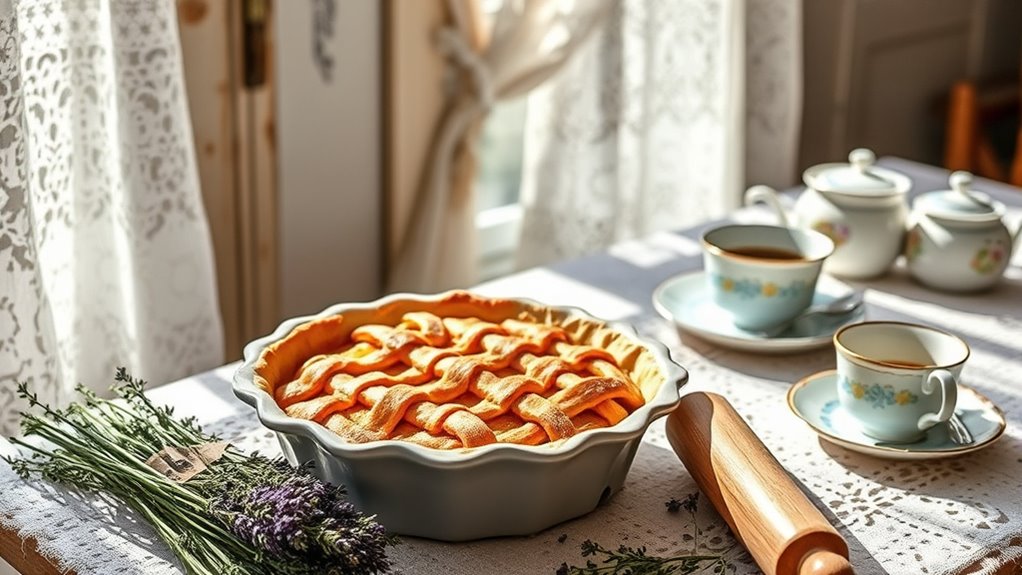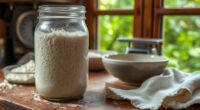To revive vintage pie techniques with a cottagecore charm, focus on simple, rustic approaches that emphasize natural ingredients and imperfect shapes. Incorporate French patisserie methods like delicate pastrycrusts and precise crimping to elevate your pies with elegance. Use sourdough or fermented dough for added flavor and a touch of authenticity. Pair your creations with vintage touches, like handmade jams or antique dishes. Keep exploring these timeless skills to truly capture that cozy, nostalgic baking spirit.
Key Takeaways
- Embrace rustic, imperfect pie shapes using hand-rolled crusts and decorative edges like lattice or crimping.
- Incorporate French patisserie techniques for delicate, precise crusts and refined presentation.
- Use natural fermentation methods, such as sourdough crusts, to add depth and authentic texture.
- Focus on simple, nostalgic fillings paired with homemade jams or butters for a cozy cottagecore feel.
- Serve pies on vintage china or linen, enhancing the vintage aesthetic and inviting, nostalgic atmosphere.

Have you ever wondered how to bring a touch of rustic charm to your baking? Embracing cottagecore baking allows you to create simple, nostalgic treats that feel warm and inviting. It’s about reconnecting with vintage techniques and infusing your kitchen with a cozy, old-world vibe. One way to start is by exploring the art of French patisserie, which emphasizes delicate, handcrafted pastries and crusts. Even if you’re new to baking, you can incorporate these classic methods to elevate your pies and tarts, giving them a refined, timeless look. French patisserie techniques focus on precision and finesse, but they also encourage patience and appreciation for the process. As you master these techniques, your baked goods will evoke the elegance of a quaint French bakery, blending sophistication with rustic simplicity.
Another essential element of cottagecore baking is sourdough bread. This ancient bread-making method connects you to generations of bakers who relied on natural fermentation. Sourdough’s tangy flavor and chewy texture add depth to your baking repertoire, and its rustic appearance perfectly complements vintage aesthetics. Making sourdough bread from scratch might seem intimidating at first, but it’s incredibly rewarding. You start by cultivating your own starter, which requires patience and regular care—much like tending a garden. Once established, you’ll use it to craft loaves with a crisp crust and airy crumb that look like they came straight from a countryside bakery. Incorporating sourdough into your baking not only enhances flavor but also aligns with the cottagecore ethos of simplicity, sustainability, and tradition. Additionally, incorporating natural fermentation techniques can boost the nutritional profile of your baked goods and promote gut health.
To truly capture the spirit of cottagecore, focus on the tactile experience of baking. Use natural ingredients, embrace imperfect shapes, and savor the process rather than rushing to the finish line. When making pies, try hand-rolling your crusts and adding decorative touches like lattice tops or crimped edges. These small details evoke vintage charm and make your baked goods feel special. Pair your homemade sourdough bread with homemade jams or butter, and serve everything on vintage china or linen napkins for an extra nostalgic touch. Incorporating elements of French patisserie and sourdough bread into your baking helps you create a collection of treats that feel authentic and timeless, perfectly suited for a cozy cottagecore aesthetic. With patience and a gentle touch, you’ll find yourself more connected to your baking—and to a simpler, more charming way of life.
Frequently Asked Questions
What Are the Origins of Vintage Pie Techniques?
You might wonder about the origins of vintage pie techniques, which stem from a rich history of pastry and regional pie styles. These methods evolved over centuries, influenced by local ingredients and cultural traditions. As you explore baking, you’ll see how historic practices like hand-crimped edges and fruit fillings reflect regional flavors and techniques passed down through generations, giving each pie its unique character rooted in history.
How Can I Adapt These Techniques for Vegan Baking?
You can adapt vintage pie techniques for vegan baking by swapping traditional ingredients with vegan substitutes like coconut oil or vegan butter for flaky crusts. Use plant-based fillings such as fruit compotes, nut-based creams, or thickened fruit purees to replicate classic flavors. Focus on textures and flavors that honor vintage pie styles, and experiment with these plant-based options to create delicious, authentic-looking vegan pies that preserve the nostalgic charm.
Are There Specific Tools Recommended for Authentic Pie Making?
You’ll want specific tools to craft authentic pie crusts and fruit fillings. A good pastry cutter helps you achieve flaky crusts, while a rolling pin guarantees even thickness. A lattice cutter or fork can add traditional patterns. For fruit fillings, a slotted spoon makes filling transfer easy, and a reliable pie dish guarantees even baking. These tools help you create beautiful, vintage-inspired pies with perfect crusts and luscious fillings.
How Long Do Traditional Pie Fillings Typically Last?
Traditional pie fillings typically last about 1-2 days at room temperature, but preservation methods like refrigeration can extend their shelf life to 3-5 days. If you’re looking to store fillings longer, consider freezing them. Proper storage and understanding the filling shelf life are essential to prevent spoilage. Always check for signs of spoilage before using, and when in doubt, it’s safer to discard older fillings.
Can These Methods Be Scaled for Larger Baking Projects?
When scaling recipes for larger baking projects, you need to adjust ingredients carefully to maintain flavor and texture. In commercial baking, scaling recipes is common, and precise measurements matter. You can definitely apply vintage pie techniques to bigger batches, but make sure you adapt cooking times and oven settings accordingly. This approach helps preserve the quality of your pies, whether you’re baking for a small family gathering or a commercial bakery.
Conclusion
As you embrace cottagecore baking, you connect with a charming tradition—did you know that 65% of home bakers say vintage techniques make their pies more satisfying? By reviving these timeless methods, you not only create delicious treats but also preserve a piece of history. So, keep experimenting with flaky crusts and hand-rolled dough. Your efforts bring a cozy, nostalgic touch to every bite, making baking feel truly special.











